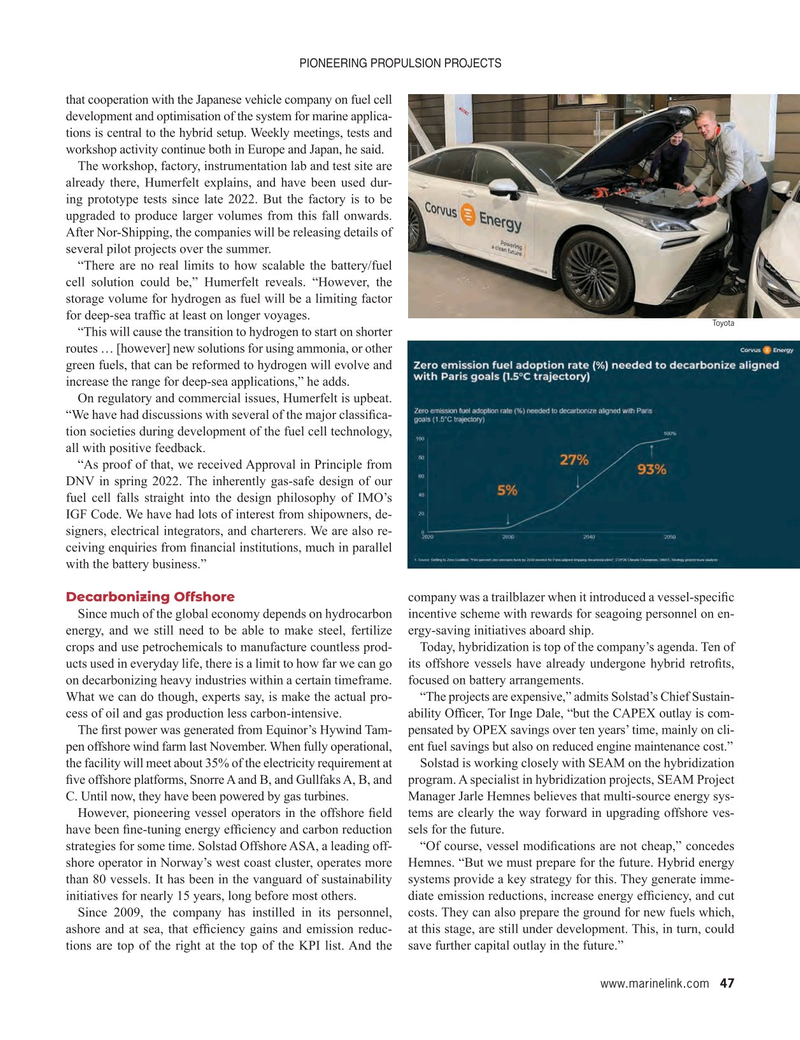
Page 47: of Maritime Reporter Magazine (May 2023)
Green Ship Technologies
Read this page in Pdf, Flash or Html5 edition of May 2023 Maritime Reporter Magazine
PIONEERING PROPULSION PROJECTS that cooperation with the Japanese vehicle company on fuel cell development and optimisation of the system for marine applica- tions is central to the hybrid setup. Weekly meetings, tests and workshop activity continue both in Europe and Japan, he said.
The workshop, factory, instrumentation lab and test site are already there, Humerfelt explains, and have been used dur- ing prototype tests since late 2022. But the factory is to be upgraded to produce larger volumes from this fall onwards.
After Nor-Shipping, the companies will be releasing details of several pilot projects over the summer.
“There are no real limits to how scalable the battery/fuel cell solution could be,” Humerfelt reveals. “However, the storage volume for hydrogen as fuel will be a limiting factor for deep-sea traf? c at least on longer voyages.
Toyota “This will cause the transition to hydrogen to start on shorter routes … [however] new solutions for using ammonia, or other green fuels, that can be reformed to hydrogen will evolve and increase the range for deep-sea applications,” he adds.
On regulatory and commercial issues, Humerfelt is upbeat. “We have had discussions with several of the major classi? ca- tion societies during development of the fuel cell technology, all with positive feedback. “As proof of that, we received Approval in Principle from
DNV in spring 2022. The inherently gas-safe design of our fuel cell falls straight into the design philosophy of IMO’s
IGF Code. We have had lots of interest from shipowners, de- signers, electrical integrators, and charterers. We are also re- ceiving enquiries from ? nancial institutions, much in parallel with the battery business.”
Decarbonizing Offshore company was a trailblazer when it introduced a vessel-speci? c
Since much of the global economy depends on hydrocarbon incentive scheme with rewards for seagoing personnel on en- energy, and we still need to be able to make steel, fertilize ergy-saving initiatives aboard ship.
crops and use petrochemicals to manufacture countless prod- Today, hybridization is top of the company’s agenda. Ten of ucts used in everyday life, there is a limit to how far we can go its offshore vessels have already undergone hybrid retro? ts, on decarbonizing heavy industries within a certain timeframe. focused on battery arrangements.
What we can do though, experts say, is make the actual pro- “The projects are expensive,” admits Solstad’s Chief Sustain- cess of oil and gas production less carbon-intensive. ability Of? cer, Tor Inge Dale, “but the CAPEX outlay is com-
The ? rst power was generated from Equinor’s Hywind Tam- pensated by OPEX savings over ten years’ time, mainly on cli- pen offshore wind farm last November. When fully operational, ent fuel savings but also on reduced engine maintenance cost.” the facility will meet about 35% of the electricity requirement at Solstad is working closely with SEAM on the hybridization ? ve offshore platforms, Snorre A and B, and Gullfaks A, B, and program. A specialist in hybridization projects, SEAM Project
C. Until now, they have been powered by gas turbines. Manager Jarle Hemnes believes that multi-source energy sys-
However, pioneering vessel operators in the offshore ? eld tems are clearly the way forward in upgrading offshore ves- have been ? ne-tuning energy ef? ciency and carbon reduction sels for the future. strategies for some time. Solstad Offshore ASA, a leading off- “Of course, vessel modi? cations are not cheap,” concedes shore operator in Norway’s west coast cluster, operates more Hemnes. “But we must prepare for the future. Hybrid energy than 80 vessels. It has been in the vanguard of sustainability systems provide a key strategy for this. They generate imme- initiatives for nearly 15 years, long before most others. diate emission reductions, increase energy ef? ciency, and cut
Since 2009, the company has instilled in its personnel, costs. They can also prepare the ground for new fuels which, ashore and at sea, that ef? ciency gains and emission reduc- at this stage, are still under development. This, in turn, could tions are top of the right at the top of the KPI list. And the save further capital outlay in the future.” www.marinelink.com 47
MR #5 (34-49).indd 47 5/1/2023 11:40:28 AM

 46
46

 48
48
